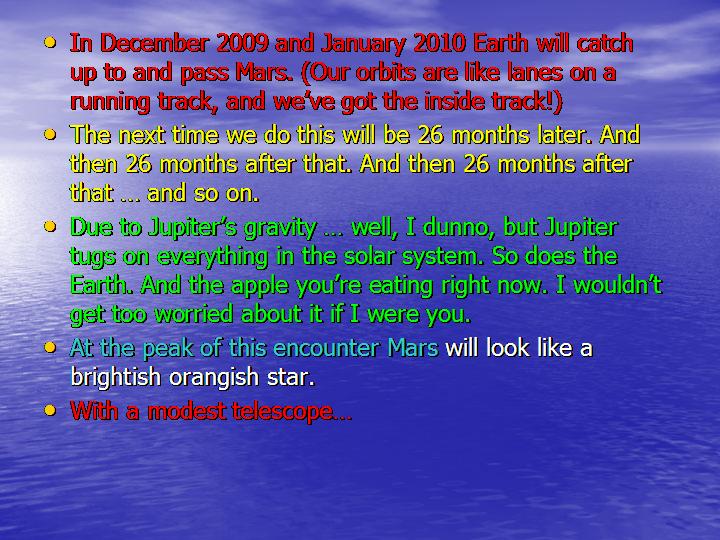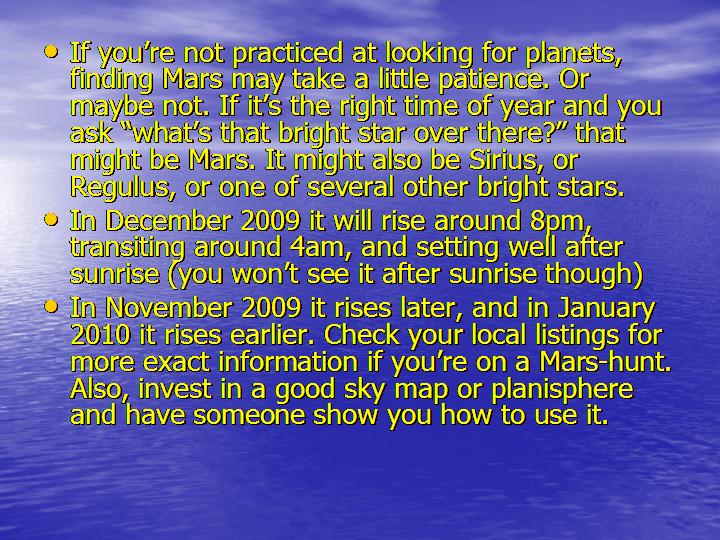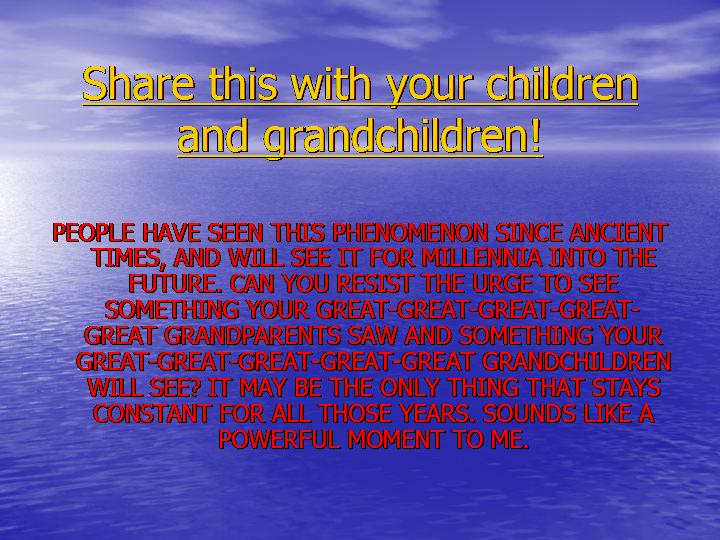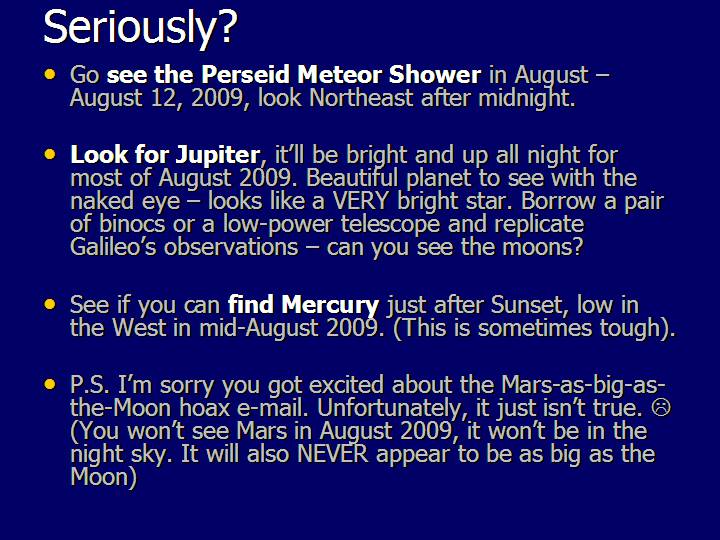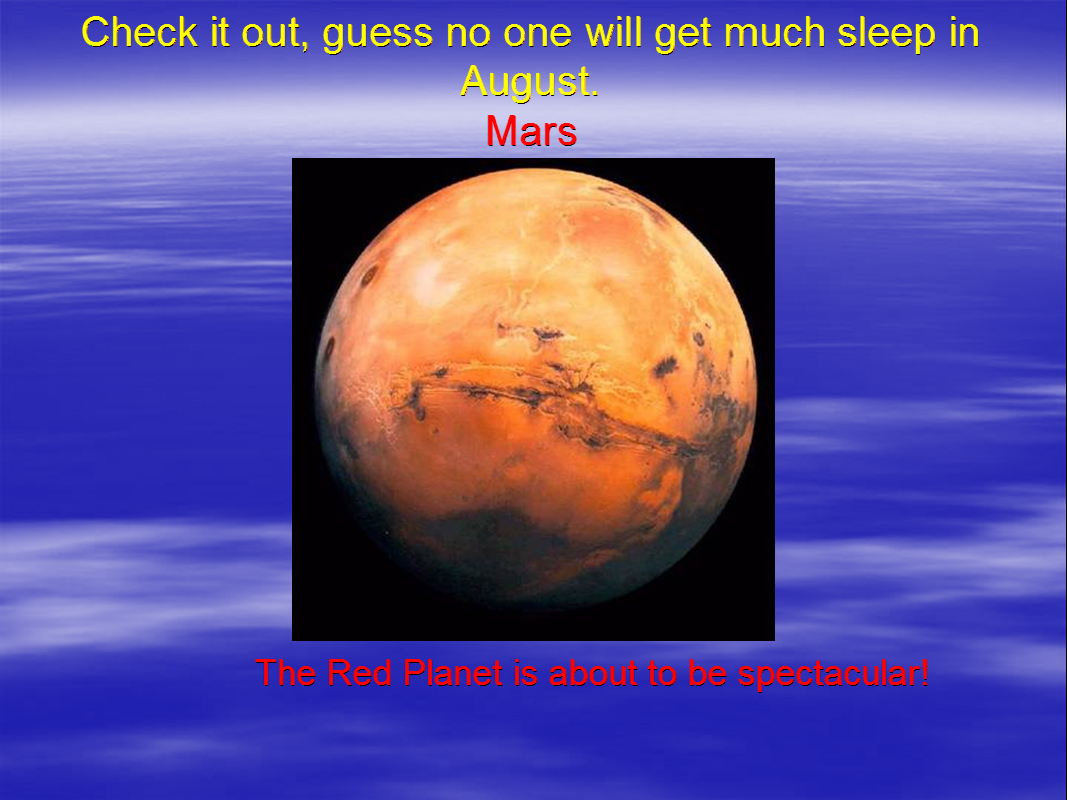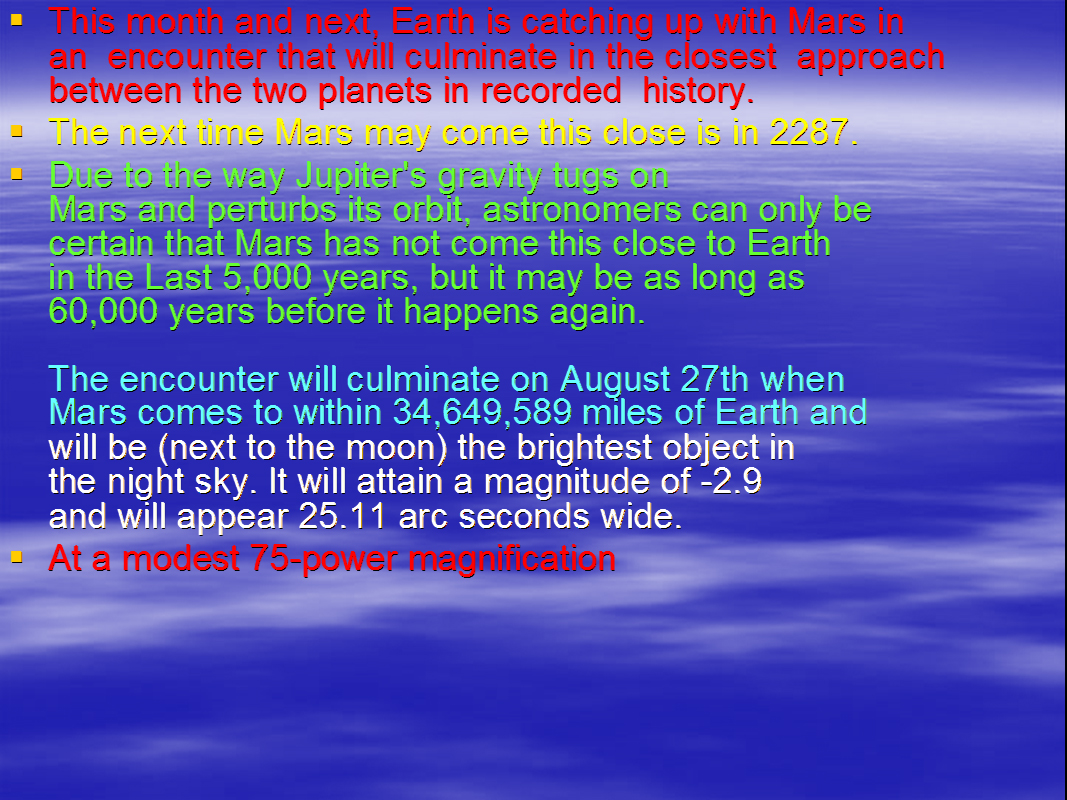Archive for 2009
 Mars as Big as the Moon 09 #2
Mars as Big as the Moon 09 #2
Okay, I couldn’t resist. For all of you out there who have also been trying to educate folks about the Mars Hoax for years, I’ve created a brief respite.
As you know, this year’s version is going around as a PowerPoint. Once you’ve seen the hoax PowerPoint, you might enjoy my … “corrected” version. If you’re squeamish about random .pps files from the internet, I’ve attached still .jpgs here, but they’re not as cool – there aren’t any annoying animations to click through. The effect just isn’t the same. Enjoy!
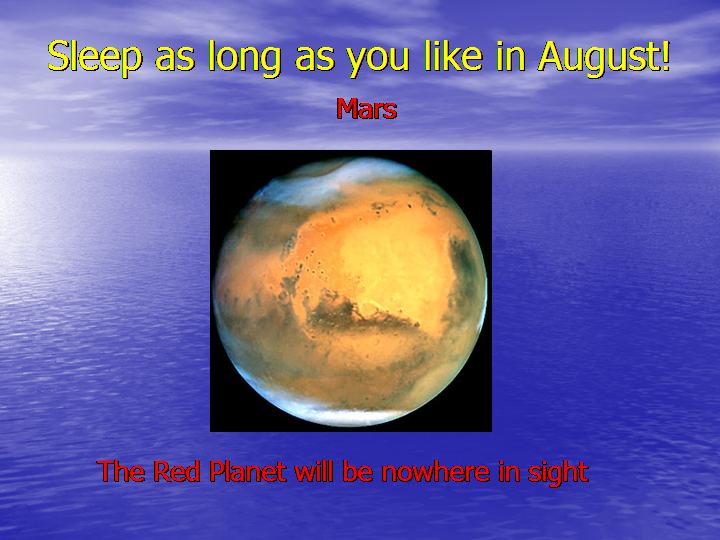
Fixed PPT Slide 1 (well, actually, Mars rises around 2 or 3am, but it starts to get light not that long after that so it might as well be nowhere in sight!)
This really doesn’t follow my rules when it comes to talking to people about the Mars hoax. Mainly it doesn’t let you down easy, and it doesn’t validate the excitement generated by the e-mails. I just made it for fun, and mostly for those who already know.
![]()
~ A l i c e !
 Mars as Big as the Moon (2009 edition) – Still Not True
Mars as Big as the Moon (2009 edition) – Still Not True
It’s back, and it’s more compelling than ever this year. My best post is last year’s. I have also made a corrected version of the e-mail that’s going around in the next post.
- First off: Mars will NOT be as big as the Moon this August (or any August).
- Secondly: Wouldn’t it be cool if it was? Well – it would look cool, but I’d be concerned about the gravitational effects on the Earth.
- Thirdly: Would you like something cool to look for this August instead? Something real? How about the Perseid Meteor Shower? It peaks on August 12th, after midnight. Look Northeast. You can make as many wishes as you like on all those “shooting stars” – you could even wish for the Mars Hoax to come true, if you like.
- Lastly: If you’re bent on seeing Mars, wait until December 2009, and you’ll see it rising in the East mid-evening. It will look like a bright-ish slightly-orange star.
Here are some quickie details:
- Mars is at opposition with Earth (as close as we get) every 26 months.
- This hoax has been going around every August since 2003.
Curious about how that opposition slips against Earth years? Here’s a short overview courtesy of the Students of Exploration and Development of Space.
- In 2003 Mars was at opposition in August, and it WAS close, from an astronomical point of view. It wasn’t actually all that exciting for the average viewer.
- In 2004 Mars was not at opposition.
- In 2005 Mars was at opposition in early November.
- In 2006 Mars was not at opposition.
- In 2007 Mars was at opposition in late December.
- In 2008 Mars was not at opposition.
- In 2009 Mars will not be at opposition (this one slips to January 2010).
- In 2010 Mars will be at opposition in January.
Mars Hoax ’09
This year the e-mail is going around as a PowerPoint attachment, complete with all the PowerPoint bells and whistles you could ever wish to avoid.
This is the PowerPoint file if you really want to see it. I’m not sure I’d trust it to be virus-free if I were you, but I did scan it for viruses, and didn’t find anything: MARS.pps. If you’d rather not risk it – screen-shots of the slides without their animated glory follow.
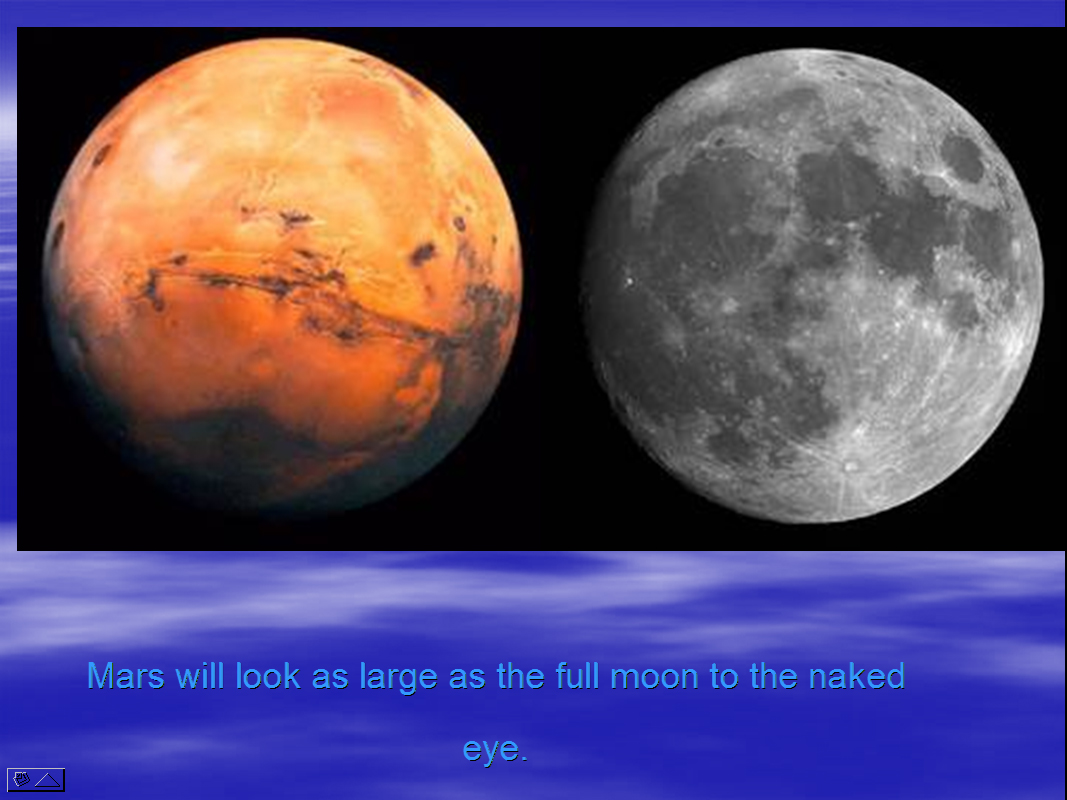
Mars Hoax PowerPoint 2009 Page 3
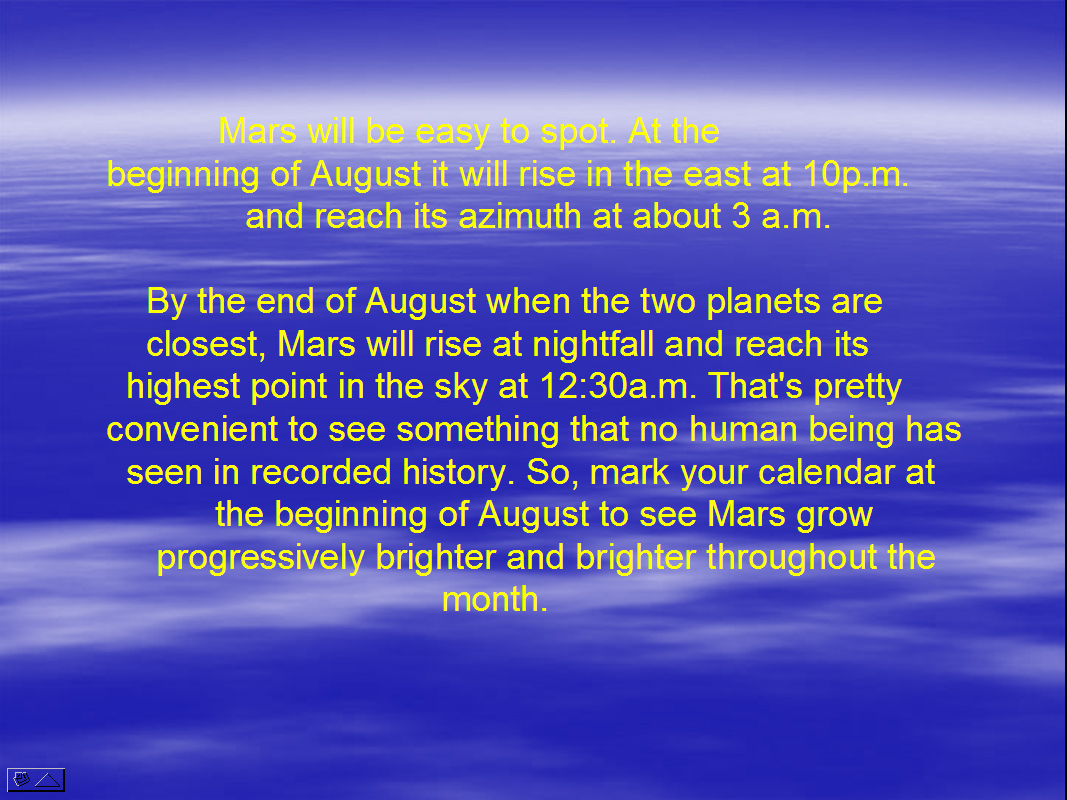
Mars Hoax PowerPoint 2009 Page 4
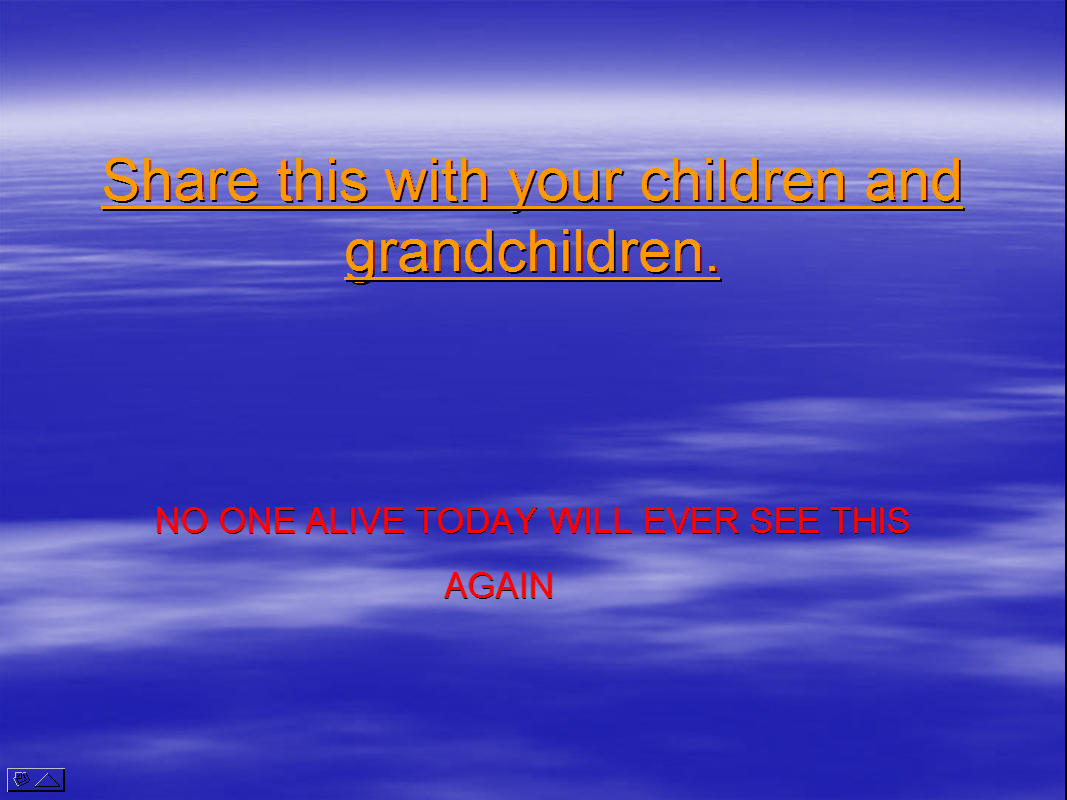
Mars Hoax PowerPoint 2009 Page 5
Anyway, more info on the history of this hoax is here.
- My first post in 2007
- My previous post in 2008 – this one includes some tips on explaining this to your friends and family when they send you this e-mail.
And some further links from other people:
![]()
~ A l i c e !
 A Few Good Links
A Few Good Links
Phil Plait, the Bad Astronomer, is having an astrophotography contest over at his blog. It is sponsored by Discover Magazine and Celestron. It should be fun, and there are good prizes!
also –
Carnival of Space #103 – over at ChandraBlog has lots of good Hubble links.
Carnival of Space #104 – at Mang’s Bat Page with some cool info on planes and rockets, as well as some great photos.
and
Carnival of Space #105 – hosted by Space Disco also has photos of a number of the featured bloggers! Also, interesting articles and an e-mail with very strange title.
I’m not in any of them, but I will be soon, and check out what others are saying while I’m quiet.
![]()
~ A l i c e !
 AstroInfo is One Year Old!
AstroInfo is One Year Old!
Well how about that, Alice’s AstroInfo has been live on the internet for a whole year! How exciting!
Time for a brief history lesson, and then we’ll get to the cake.
Remember?
AstroInfo didn’t begin as a blog. A few years ago, while I was still in school, Steve White wrote several one-page papers for the planetarians of the Pacific Science Center to help them be more on top of some of the cool current goings-on Out There in space. These pages were lovingly referred to as “Fornax Facts.” (or was it “Fornax’s Facts”? I can’t remember). You see, planetarians at Pacific Science Center have code-names that we usually choose for ourselves. I happen to be called Altair, Steve is Fornax, Holly is Amalthea … etc. Well, Steve got an awesome full-time job teaching Calculus (he still stops by now and then to do some shows of his own), and the job of answering staff questions came to me.
Soon thereafter the IAU made their epic decision regarding Pluto. Most people were confused, or they understood it, but were having trouble making the explanation straightforward enough to include in the limited time we have in a planetarium show. So I wrote the first AstroInfo though I hadn’t quite named it that yet (I’m sorry, it looks like the whole article didn’t come through the transfer, I’ll work on fixing that). That article came out on August 25th, 2006.
Well, almost two years later I had amassed quite a few AstroInfos, and in addition to e-mailing them out to staff and other interested parties I decided to put them up on the internet for anyone who might be interested. Phil Plait and Pamela Gay were hosting a workshop at the 2007 Astronomical Society of the Pacific/American Astronomical Society meeting on astronomy education in cyberspace. They convinced me that Facebook was not an evil, privacy-invading organization, that it could indeed be (carefully) used as a tool, and they suggested WordPress as a good place to start a blog.
Well, I’ve come quite a way: AstroInfo is now hosted on its own site, running WordPress, and I’m on Twitter and Facebook.
I promised you cake
You already know that I like recipes, so here’s a good one. The measurements are American and Fahrenheit. I apologize to those of you who live elsewhere. To make up for this, the cake is Milk-, Egg-, Soy- , Peanut-, and Nut-free (M,E,S,P,N in Food Allergy and Anaphylaxis Network speak).
Ugly Cake
via my friend Corinne Cooley
- 1 ½ Cup Flour
- 1/3 Cup Carob or Flour (or cocoa powder)
- 1 Tsp Baking soda
- ½ Tsp Salt
- 1 Cup Sugar
- 1 ¼ Cup Water
- ¼ Cup Canola Oil
- 2 Tsp Vanilla
- 2 Tbsp Vinegar
Directions:
Mix dry ingredients in 8in circle pan or 9x9in square pan.
Mix wet ingredients. Stir into dry ingredients.
Bake for 45 minutes at 350°F
Prep time: 5 minutes
Bake time: 45 minutes
Notes:
This is the world’s easiest and most flexible cake recipe. Double it. Triple it. Make it into muffins. Top it with brown frosting and as many colors of sprinkles as you can find (this is where the name “Ugly” cake comes from).
![]()
~ A l i c e !
 Carnival of Space (#101, #102)
Carnival of Space (#101, #102)
Oops, I have some catching up to do:
Go see Carnival of Space #101 at Robot Explorers
and
Carnival of Space #102 – at The Spacewriter’s Ramblings
![]()
~ A l i c e !
 Sunspots
Sunspots
I’ve gotten several questions about sunspots and the Sun lately, so I’m going to start off with a post about the basics of sunspots. Enjoy, but remember, NEVER LOOK DIRECTLY AT THE SUN without proper eye-protection.
What is a sunspot?
Let’s use George Fisher’s words: “A sunspot is a dark part of the sun’s surface that is cooler than the surrounding area. It turns out it is cooler because of a strong magnetic field…”
Why is it darker?
Because the sunspot is cooler than the surrounding plasma of the Sun. It is actually still very hot: ‘round about 4000 Kelvin (that’s like 6750 degrees Fahrenheit).
Why is it cooler?
There is a strong loop of a magnetic field going into each pair of sunspots. This makes it harder for the plasma to flow in that area as it does elsewhere on the Sun, so the area cools down. (There’s less convection bringing hotter plasma from deeper in the Sun to the surface there).
Wait, what magnetic field? What? How is a sunspot formed anyway?
Just like the Earth, the Sun has a magnetic field. Neither the Sun’s nor the Earth’s fields are formed the way a regular magnet’s magnetic field is formed – they’re both formed like the magnetic field of an electromagnet. (There are two ways to create a magnetic field: 1. Have a magnet, or 2. Have moving electrons) In the case of the electromagnet (and the Sun and the Earth) electrons are moving, creating a magnetic field.
The Sun is made up of plasma and is very fluid, so as it spins different parts spin at different rates. (Stir your tea tomorrow morning – the tea at the sides of the cup spins around the edge of the cup a lot faster than the tea in the middle. If you have trouble seeing it add a drop of milk or food coloring as it spins. Now imagine how much more complicated that would get if you had a sphere of tea that was spinning and boiling.) That plasma that spins at different speeds is made of the electrons that are causing the Sun’s magnetic field. There are also many other motions going on within the Sun’s plasma. This makes the Sun’s magnetic field get very tangled and twisted.
Whenever a tangled loop of the Sun’s magnetic field pokes through the Sun’s photosphere we get a pair of sunspots: one at one end of the field, one at the other end of the field. These loops (and the associated spots) usually last a couple of weeks.
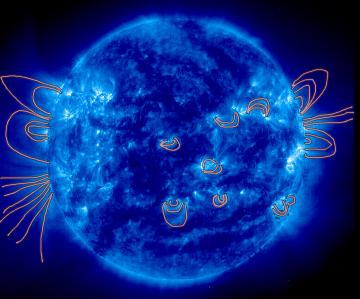
Part of the Sun’s magnetic field. The lines are “magnetic field lines”: a way of visualizing a magnetic field. Credit: NASA/SOHO 2002
Why don’t we get “Earthspots”?
The Earth isn’t made of plasma. This makes our magnetic field less prone to tangling, and if a loop of our magnetic field DID poke through our surface we’re not hot enough or made of the right stuff for it to affect the temperature. (I’m pretty sure – maybe we should check with a solar physicist on this one).
Where’d I Get My Info?
Berkeley – Good info, well written. More advanced than what I wrote.
![]()
~ A l i c e !
 May-June Sky
May-June Sky
Notable Sky Objects
SATURN
Saturn is still tilted edge-on to us, making fun telescope viewing. Look for it just below Leo’s tail. Note of interest regarding Saturn observation: Carolyn Porco, Cassini Imaging Team Leader, was the science consultant for the new Star Trek film – so when you see it keep your eyes peeled for the obvious contributions of an intelligent science consultant. If you want to watch for it, her name is 2/3 of the way through the credits, just AFTER the Klingon/Romulan language consultant.
JUPITER
We’ve got both gas giants this month! Jupiter will be rising late around 2am at the beginning of May and slowly creeping earlier till it rises about 10pm at the end of June. It should be shining bright for your viewing enjoyment.
EVENTS
June 6 – Moon will hide Antares, if you’re watching from the United States.
June 20 – Summer Solstice!
New Constellations
SCORPIUS – The Scorpion
SCIENCE: Scorpius is in the same direction as the Milky Way – so if you imagine the shape of the constellation as a teapot, the very middle of our galaxy would be the tea pouring out of that teapot. That’s where the supermassive black hole at the center of the Milky Way is – but you’ll never see it, no matter how hard you look.
Antares (alpha scorpii) red supergiant of variable brightness with a close blue-white companion orbiting every 900 years. Means “Rival of Mars” (anti-Ares) or “Like Mars”
MYTH: To the Chinese it was a dragon; in the South Pacific, it was Maui’s fishhook used to pull up islands from the ocean floor.
The Summer Triangle (mostly):
Cygnus(the Swan) and Lyra (the Lyre/Harp) reappear, and the bright star from Aquila (Altair). The summer triangle (as you can tell by the name) will be directly overhead come summer, but now it’s low in the East, a harbinger of brighter days to come.
CYGNUS – The Swan
SCIENCE: Albireo – Cygnus’ head is the prettiest double star in the sky. Look through a telescope and it separates into a glowing gold star, and a tiny blue point. This is a good thing to suggest for people with telescopes at home.
MYTH: Do you like gory details? When his brother Phaethon was killed by Zeus and scattered all over the Earth, Cygnus picked up all the pieces. The gods laughed, calling him a “bobbing duck,” picking up all those pieces. Then they started to realize that maybe he was doing a good deed, so they put him in the sky as a “noble” bobbing duck – a swan.
LYRA – The Lyre
SCIENCE: M57, the Ring Nebula is between the bottom two stars in the constellation. It’s pretty hard to pick out, even with a small telescope, but it is a good target for larger scopes, and Hubble has a beautiful image of it.
DELPHINUS – The Dolphin
This tiny constellation is as cute as a bug’s ear … or a dolphin’s. Probably one of the easiest constellations to spot – Delphinus is isolated in a dark part of the sky near Aquila.
MYTH: The four stars that make Delphinus’ head are also called “Job’s Coffin.” You don’t often think of Christianity as the underdog, but in our sky it is: the sky is dominated by the Greek names and stories.
“Tiny” Guys
Going for the Gold? Here’re this month’s itty-bittys.
LYRA – The Lyre
CORVUS – The Crow
CRATER – The Cup
COMA BERENICES – Berenice’s Hair
LYNX – The Lynx
SEXTANS – The Sextant
HYDRA – The Sea Serpent (Big and dim)
LACERTA – The Lizard
LEO MINOR – The Small Lion (Between the Big Dipper and Leo)
VULPECULA – The Fox
SAGGITA – The Arrow
SCUTUM – The Shield
LIBRA – The Scales
CAMELOPARDALIS– The Giraffe
Returning Constellations
BOÖTES – The Herdsman
HERCULES – Hercules
CORONA BOREALIS – The Northern Crown
VIRGO – The Virgin (or “Princess”)
LEO – The Lion
CANCER – The Crab
GEMINI – The Twins
CEPHEUS – King Cepheus
DRACO – The Dragon
URSA MAJOR – The Great Bear
URSA MINOR – The Little Bear
CASSIOPEIA – The Queen
Where’d I Get My Info?
My memory, and Zeta Strickland
![]()
~ A l i c e !
 Smithsonian Photography Contest
Smithsonian Photography Contest
click! Photography Changes Everything is an online exhibit put on by the Smithsonian, and they’re looking to celebrate the International Year of Astronomy with us!
If you like photography and you like writing you might like to submit a photo and a short story.
This month’s focus: Seeing Other Worlds
Submit a photo showing how photography influences our ability to see ‘unseen’ or unfamiliar worlds to become part of this month’s focus, Seeing Other Worlds.
Some things to consider: How can photography help us see things that would otherwise go unnoticed in our everyday lives? How does micro- and macro- photography (e.g. from microscopic bacteria to galaxies far beyond the earth) change our perception of the world and our place in it? How do new imaging technologies and software (e.g. MRI’s, CAT scans, Google Earth, etc.) change what we’re able or want to see? How does photography shape awareness and shape our perception of other communities, cultures and lifestyles?
I can’t find a deadline, and I’ll bet that’s because the exhibit goes on all year, but with different themes at different times.
It’s an interesting exhibit – take a look around.
![]()
~ A l i c e !
P.S. I promise to have an astronomy post for you soon – I’m working on putting together an overview of the new sky.
 Carnival of Space #100
Carnival of Space #100
Wow – this carnival is one not to miss. Hosted by the One Minute Astronomer, this week’s Carnival of Space is a wonderful collection of awesome astronomy news and explanations.
![]()
~ A l i c e !
 Earth Revealed: Astronomy Day 2009 at Pacific Science Center
Earth Revealed: Astronomy Day 2009 at Pacific Science Center
Come one, come all to Pacific Science Center’s celebration of Astronomy on May 2, 2009 from 10am-6pm.
Here’s the quote from our website:
Earth Revealed
This spring, Pacific Science Center celebrates local scientific research focusing on all of the amazing things scientists learn by looking at Earth from satellites circling our planet in space. This series of programs showcases local scientists, allowing our visitors to meet and participate in hands-on activities with the people who conduct this cutting edge research.
[Our] month long celebration [Earth Revealed] culminates with a Special Event, Saturday, May 2, 10:00 a.m. – 6:00 p.m. Join Pacific Science Center as we showcase Earth as you have never seen it before. Over twenty hands-on activity stations will be ready to explore, all facilitated by local scientists. Additionally, KING 5 meteorologist, Jeff Renner will make a special presentation! This event is targeted to families with elementary and middle school aged children although will be most appropriate for kids 8-years-old and up.
Awesome Science!
Our ability to look back at Earth from space, using satellites and other space craft, has transformed what we know about our home planet over the last fifty years. From space, we can see weather patterns such as hurricanes and features such as glaciers, volcanoes and oceans in a whole new way. For the first time in human history, we can see ourselves living on and altering a dynamic planet. Discover this fascinating area of research during Pacific Science Center’s Earth Revealed: A View Of Our Planet From Space events!
Learn how scientists:
- Understand and predict hurricane intensity by combining satellite data with information gathered during flights into real storms!
- Study the beautiful and awe inspiring Northern Lights!
- Determine the make-up of Earth’s atmosphere, and then look for similar planets outside of our own solar system!
- Discover how fires affect our forests!
- Gather information about the location and thickness of sea ice and glaciers!
Partners:
University of Washington participants include Applied Physics Lab, College of Forestry Resources, Department of Astronomy, School of Oceanography, Department of Atmospheric Sciences, Department of Earth and Space Sciences and Department of Electrical Engineering. Other event participants include Microsoft, JISAO, Central Washington University, KING 5 News and NOAA National Weather Service.
In addition we’ll have planetarium shows (first come, first seated, and seating is LIMITED!) every hour on the hour, astronomy crafts and activities scattered throughout the buildings.
I got to meet a couple of these scientists last week at one of the events that have been going on all month. They’re fun to talk to, have cool stuff to show you, and best of all make it easy to understand!
![]()
~ A l i c e !
